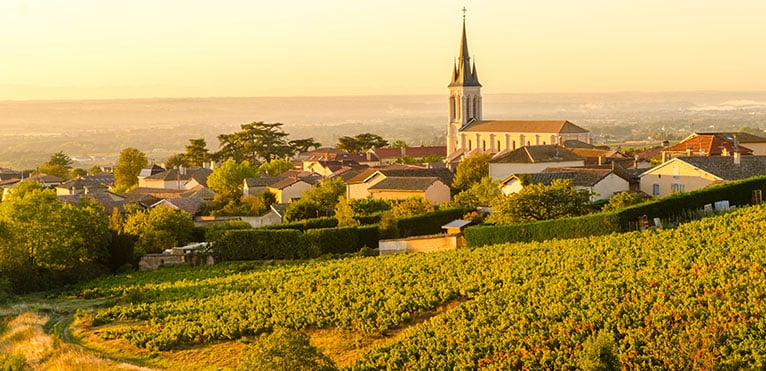
Contents
The Beaujolais wine appellation belongs to the Beaujolais region. This region, which lies north of Lyon, extends to the south of the Saône-et-Loire department and certain municipalities in the Rhône department.
Situated in the south of the region and one of its twelve Protected Designations of Origin (AOC), the Beaujolais vineyards produce mainly red wine from the Gamay grape, but also a few white wines from the Chardonnay grape (representing only 3% of total production).
The history of AOC Beaujolais is marked by the Romans
Beaujolais winegrowing history dates back to Roman times, which inspired the name of one of its grands crus, Juliénas, an allusion to Julius Caesar (the nine other grands crus are Brouilly, Morgon, Fleurie, Chiroubles, Chénas, Saint-Amour, Côte de Brouilly, Régnié, Moulin à vent). It was the seigneury of Beaujeu in the Middle Ages that gave its name to the appellation. A production reserved for local consumption until the 17th century, Lyon’s Bouchons and taverns quickly became very fond of these gourmet wines.
The Beaujolais appellation was born in 1937, followed by the internationally successful Beaujolais Nouveau in 1951. Symbolizing a festive, easy-drinking wine, it is enjoyed on the third Thursday in November. He inspired René Fallet to write his book
The beaujolais nouveau has arrived,
as well as Jean Carmet and Michel Galabru.
AOC Beaujolais is “the most sensual of vineyards” according to the Revue du Vin de France
The Beaujolais vineyards lies to the south of the Beaujolais region, more precisely from Villefranche. As with most Beaujolais, semi-carbonic maceration is used for vinification, and the vines are carefully trained.
The Beaujolais vineyards cover an area of 7,000 hectares and are located on the slopes of the Monts du Beaujolais, rising to 700 m or sometimes more than 1,000 m in altitude. It enjoys a temperate, semi-continental climate.
AOC Beaujolais is a delicious, gourmet wine
The grape variety used for Beaujolais wines is Gamay noir à jus blanc (98%) for red and rosé, and Chardonnay (2%) for white.
Fruity and delicious, Beaujolais wines are characterized by their beautiful purplish color. On the nose, Beaujolais is a very fruity, aromatic wine, with strawberry and raspberry predominating. Its structure on the palate is fine and discreet. Beaujolais is a semi-ageing wine, with an ageing potential of between 2 and 7 years. Some white Beaujolais from the extremities of the Mâconnais also stand out.
AOC Beaujolais is a wine with supple tannins that goes well with charcuterie.
Seductive, fresh and gourmet, Beaujolais wines are generally paired with meat or cheese, and are particularly good with rillettes, trout à la bourguignonne, pike-perch fillets, or desserts such as pear à la beaujolaise.
As far as red wines are concerned, Beaujolais is the perfect match for a savory lentil dish. There’s nothing like a Beaujolais, a simple, fresh wine: Beaujolais primeur when it’s in season, Beaujolais tout court the rest of the year. Chamour”, a rustic pumpkin cake, is the perfect regional specialty to accompany a Beaujolais-rosé. Beaujolais wines should be drunk between 12° and 14°.
1959 was one of the great Beaujolais vintages
The Beaujolais appellation is distinguished by its best vintages: 2009, 2005, 1976, 1971, 1969, 1966, 1961, 1959, 1952 and finally 1949. In particular, 1971 and 1952 produced exceptional vintages.
The Beaujolais appellation particularly stood out for its vintage of the century in 1969, an exceptional year. 1959, known as the millennium vintage, is considered to be the most excellent year ever.
The Beaujolais AOC boasts family estates with exceptional sites
The K Family
The members of Famille K, a Beaujolais winery, are Marianne, Benoit and Jeanne. This family decided to escape the hustle and bustle of the Paris region to settle in the Beaujolais terroir. Since 2018, they have been passionately cultivating the vines there to produce a quality wine accessible to all. In fact, the Famille K vineyard is maintained without the use of synthetic products or chemical pesticides.
This 12-hectare estate produces wines whose names resonate with the family’s own members. Wines such as “Le Père”, “La Mère” and “L’Héritière” are all original, bringing the producer even closer to the consumer.
Domaine du Château de Lachassagne
Olivier Bosse-Platière and his wife Véronique now own the Château de Lachassagne wine estate. The latter is located some twenty kilometers north of Lyon, overlooking the Saône plain. This estate enjoys a great reputation in the wine industry, as evidenced by numerous documents dating back to the end of the 19th century.
The quality of our wines is due in no small part to their very long conservation in the Château’s cellars (25 to 30 years). This estate is particularly noted for the quality of its whites, a quality recognized by the award of numerous medals.